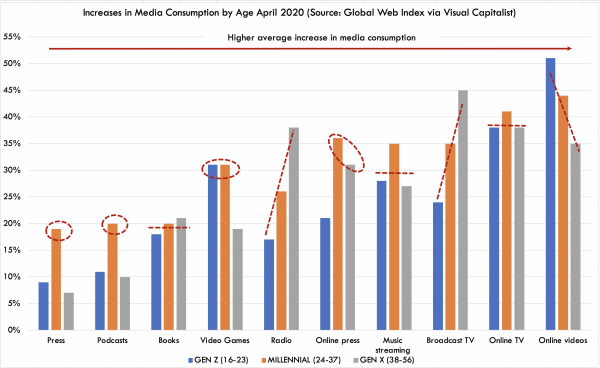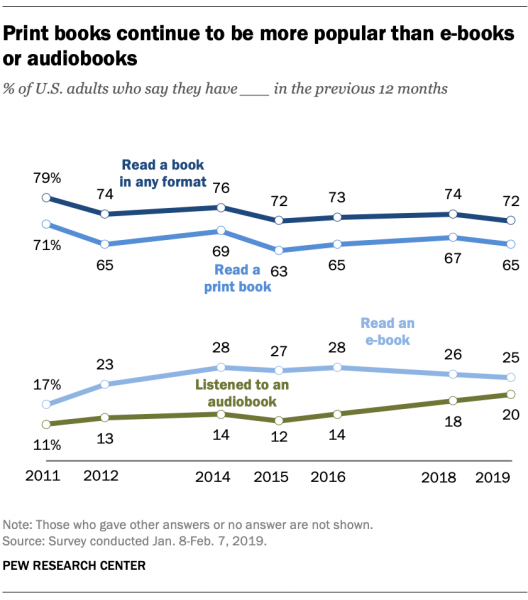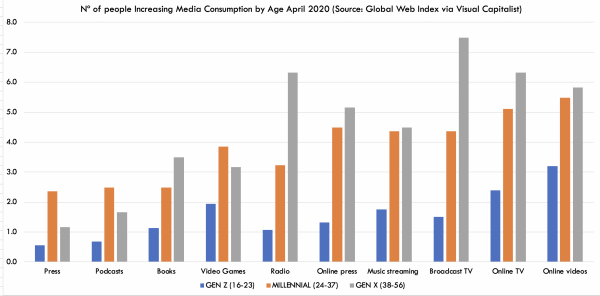How has media consumption changed by generation?
I recently came across an interesting graphic illustrating increases in media consumption by lifestage during this period of pandemic-induced social isolation (1), using a Global Web Index study of 4,000 internet users in the US and UK.
The marketing press love to portray ‘Gen Z’ and ‘Millennials’ as being totally different from older ‘Gen X’ folk like me. Based on this, you would expect media consumption changes to be radically different across age groups. But is this case?
1. We’re ALL hungry for more content
The first thing which hit me is how all media channels have seen increased consumption across all age groups: 87% of U.S. consumers and 80% of UK consumers say they’re consuming more content.
This confirms findings from Nielsen that I posted on here, showing that people in the US were watching more media, with 18% to 29% more TV being watched in mid April versus 2019, depending on age. More than ever, we need brands to inform, entertain and provide some sense of normality.
However, just when we’re all hungry for MORE content, brands are cutting back on marketing, with with 69% making major cuts in Q2 2020 in what Nielsen call ‘the pandemic paradox’.
This presents an opportunity for brands that are now out of ‘survival mode’ and can afford to invest in brand communication. And, as we saw in last week’s post, the good news is that a new campaign doesn’t necessarily mean you need to spend on creating new content: testing shows that pre-Covid ads are, on average, still effective today.

2. Some differences DO exist by lifestage …
There are some differences by lifestage, in line with what you would probably guess.
Younger skew: includes video games and online videos, with bigger increases here with Gen Z (16-23) and Millennials (24-37). BUT, note how even here the level of increase with Gen X (38-56) is still pretty big, with 19% playing more video games and 35% watching more online videos.
Millennial skew: conventional press and podcasts have a peak with Millennials
Older skew: radio and broadcast TV has seen bigger increases with Gen X people. But again, see how younger lifestages are also watching more TV and listening to more radio.
3. … but there are also important similarities
Online TV and music streaming have seen some of the biggest increases in consumption. And here it is striking to see how this % increase is similar across life stages. This shows how with the maturing of these technologies their usage has become increasingly mainstream. This is helped by services such as Apple Music and Netflix offering ‘family packages’, where all family members can access the service for a monthly fee.
A special shout out has to also go to good old physical books, which have seen an increase in consumption across all life stages too of c. 20%. This shows that predictions that physical books would die altogether were premature, as I posted on in a post back in 2013 here. Physical book reading has remained well above ebook reading over the last few years (see below).

4. Why older Gen X consumers matter
The Global Web Index study seeks to dramatise differences by life stage t0 fit with a narrative about Gen Z and Millennials consumers being key to the future of brands, especially in terms of digital channels. However, what this study doesn’t look at is ABSOLUTE changes in media consumption, by taking into account that the size of these groups.
There are c.6.3million Gen Z in the UK and 12.5million Millennials. But the Gen X group in the study is much bigger at 16.6million (2).
So, looking at absolute numbers, Gen X accounts for the biggest increase in consumption for 7/10 media channels, with the exceptions being podcasts, video games and press, where Millennials lead the way.

In conclusion, these results show how care is needed to not jump to stereotypical conclusions about media habits when planning your marketing campaigns. Certain media, such as music streaming and online video, present opportunities to reach a broad target. And this study is another example showing how broadcast TV is not dead yet, enjoying the biggest jump in consumption for Gen X and the 3rd biggest for Millennials. Finally, don’t get seduced by siren calls suggesting your focus all your efforts on the exciting Gen Z consumer. In terms of absolute numbers, and even more so in terms of spending power, older Gen X consumers are of critical importance.
We explore how to use different media in-depth on our brandgym Mastering Brand Growth program. If you’d like more info on the program, simply pop your name and email in the form below (we’ll also send you the weekly brandgym blog email and brandgym Academy news, but you can opt-out at any time).
Sources:
(1) https://www.visualcapitalist.com/media-consumption-covid-19/
(2) https://www.statista.com/statistics/281174/uk-population-by-age/


